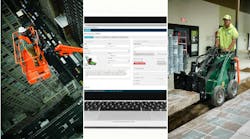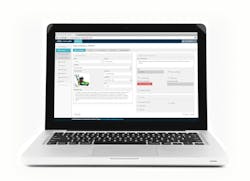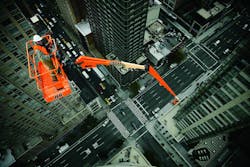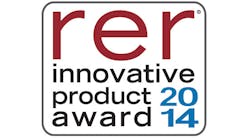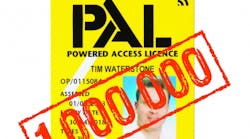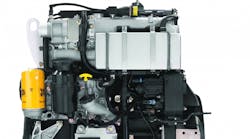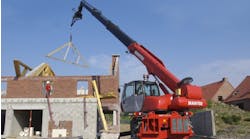Although we tend to say it every year, the entries in this year’s Innovative Product Award were particularly strong. Multiple judges on the panel observed that voting was difficult in light of the consistently high-quality candidates. It’s challenging to pick a favorite within a single category, such as compaction, power generation, high reach, earthmoving, power tools or software. It’s even more daunting to choose an overall winner, trying to compare a 185-foot boomlift with a skid-steer loader or a hydraulic breaker. One of this year’s sleepers in the miscellaneous category was a comprehensive training program run by United Rentals called United Academy, which resonated with the voters and finished just outside of the top three.
That top three included Point-of-Rental Systems’ CLOUD, which took home the gold; silver winner JLG Industries’ 1850SJ, the world’s highest self-propelled aerial work platform; and the bronze winner, Triple E Equipment’s Sherpa 100ECO, a battery-operated skidsteer loader.
Other category winners that scored high in the overall voting were Perkins Engines’ twin turbo 1206FE70TTA; Atlas Copco for its Dynapac CA1300 D/PD soil roller; Wacker Neuson’s 803 Dual Power mini excavator; and HiPower Systems’ HRNG natural gas generator.
Quite a few others scored highly as well, and all will be displayed over the next two issues of RER.
GOLD WINNER: Look to the Cloud
Point-of-Rental Systems: CLOUD. Software as a service has been around for a while now, but Point-of-Rental’s new CLOUD system takes it a step further, and, according to the company, a whole lot faster. As the Point-of-Rental staff explains it, most software products use what they would call the “waterfall method.” But the agile methods used in the CLOUD product enable Point-of-Rental to continually update and refine its software.
“Every year most software manufacturers come out with a new release,” says Point-of-Rental CEO Wayne Harris. “And lots of new features are piled into this one release. But the agile model that we are using with CLOUD is different. Instead of throwing a bunch of programmers into a room for a year and then coming out with a product, what we do is have constant feedback. We talk to our customers, we implement the features, and two weeks later we give them to the customers. We can keep on enhancing every two weeks, and every two weeks there are new features added to the software. It allows for much more rapid development and it allows for the software to be developed in lockstep with the customers so the customers can give real-time feedback about the changes that are being made. In the waterfall method, it doesn’t work so quickly.”
In the past, when any individual user or business purchased software for a desktop system, they’d go to a store or order the software online, and it would come in a package along with a lot of printed documentation. With the advent of cloud computing, the product doesn’t need to be packaged.
“One of the most innovative aspects of the product is the way that it is given out to customers and the way it is updated with new features,” Harris says. “The software is a living organism, it continues to grow and refine and get more features constantly. The uniqueness is how it is being developed.”
Because routine navigation is not processed through a server, functions can happen much quicker than traditional Software-as-a-Service products. For example, if a rental company is sending an item on rent, it can take a picture of the machine and it can be instantly uploaded onto the rental contract. It doesn’t have to go through multiple steps to get that picture onto an on-premise server.
“On a cloud product, any internet-connected device has the capability of making real-time updates without having to go through intermediary steps,” says Harris. “And what that really allows for is scalability. This means you can spin up customers or an entire business very easily on a cloud product, whereas with an on-premise server that takes a lot of back-end setup and configuration.”
Another feature of Point-of-Rental’s CLOUD is an installation system that takes a matter of minutes. “It’s done online,” says Harris. “You fill out your company name and address and put in your credit card information, it’s all automated. You get an e-mail confirmation with your log-in information, you log in and there’s a wizard that goes through setting up your parameters, your store hours, your address, your accounting methods and so on. Once you’ve done that you’re ready to import your items and start writing contracts.”
If a rental company has its inventory or parts listed on spreadsheets or some other system, it can import those items to the CLOUD product. “There are still features you will want to put in, specs and packages and things like that, but they don’t necessarily have to be done on Day One.”
CLOUD is available by monthly subscription, negating costly up-front installation fees. The software only requires a web browser to access and is described by makers as “lightning fast.” Features include the ability to upload photos to track equipment condition, process credit cards, and access an online storefront that empowers customers to easily reserve and pay for items. Equipped with QuickBooks exports, CLOUD supports easy integration with existing accounting software.
New transactions can be created with a simple-to-follow wizard, and existing transactions can be modified at any point. With many pre-defined filters available, CLOUD’s Workbench shows active transactions at a glance and highlights any overbookings. Additionally, by automatically configuring 2D barcode readers, rental companies can easily add items to a transaction with the item’s barcode, or create new customers by simply scanning a driver’s license.
CLOUD’s flexible design can be used in any sized business and easily communicates between multi-store locations. Even companies outside of the rental industry are turning to CLOUD for inventory-tracking needs.
SILVER WINNER: JLG flies to 185
JLG Industries 1850SJ. In a year where a software system is taking home the gold medal, a different kind of computer software system contributed significantly to the creation of JLG’s 185-foot boomlift, clearly one of the most innovative products not only of this year but in the history of the aerial industry. JLG gave its engineering department the charge to figure out how high the company could reach with a boomlift and still be able to put the product on a readily available trailer that rental companies use.
“When we launched the JLG 150HAX back in 1991, we showed it was possible to go higher than 110 feet but at that time we weren’t able to do it and put it on a standardly available trailer without a special permit, we had to get an overwidth permit for that one,” says Bill Dovey, product manager, booms, JLG Industries. “But since then, with computers and design technology we are able to design things smarter. Using our CAD system and 3D imaging we can design something and see where the stresses are before we actually weld it together. This gives us the ability to try different things and see what is possible.”
The 1850SJ has an unprecedented work envelope of more than 2.9 million cubic feet, and a 1,000-pound platform capacity. The telescopic jib extends from 13 to 20 feet, giving the unit a jib pivot to the edge of the platform of 25 feet. The unit has a horizontal outreach of 80 feet.
Dovey says one of the strongest features of the machine is its LCD panel on the control box. “It shows the operator where in the work envelope the platform is,” he says. “Without that, as you go up in the air you have no points of reference, you can’t tell where you are in the work envelope and how much further you might have to go. But with the LCD panel, you can tell if you’re well within the safe operating zone or you might be approaching the end of the allowable operating radius.”
As the operator approaches the end of the permissible operating radius, the 1850SJ will automatically slow down and eventually stop. The LCD panel shows the operator where he is and what controls are available to get him out of that position. “That’s a huge comfort factor for the operator,” Dovey adds.
Another strong feature is the load pin at the bottom of the lift cylinder that senses the load. “The software package compares the load on the load-sensing pin and compares that to the information provided by the boom angle sensor and the boom length sensor,” says Dovey. “If all that information agrees, then you have a green light and you’re free to operate. This is all technology that’s available to us now that wasn’t available years ago.”
The operator will be unable to operate the machine if he overloads the platform or extends it too far. The LCD panel will give the operator a diagnostic trouble code that can be looked up in the operator manual to see what the issue is, or, if necessary, call a technician.
With such a large work envelope and the telescoping jib, the operator has considerable “up-and-over” capability, and the ability to reach up and then telescope out. The 1850SJ facilitates projects such as structural steel framework on the roof of a stadium, getting in among the tubing at a petrochemical plant, performing ductwork, work on radio or cell towers and many more applications.
For the most part the controls on the 1850SJ are similar to those on other JLG boomlifts, but there are additional controls, such as the envelope management system, which has an additional toggle switch where the jib telescopes. “That envelope management system gives you one more thing to check before putting the machine to work at the beginning of the day,” says Dovey. “But it’s easily done. The operator, from the ground control, just raises the boom to horizontal, telescopes out until it stops, checks the witness mark, brings it back, pushes the button and the green lights come on and you’re good to go.”
The 1850SJ is designed to be easily serviceable, with good access to all the major components. The machine features three different steering modes, making the machine easy to maneuver on congested jobsites. It comes with a 99.8-horsepower turbocharged Deutz diesel engine. No oversized load permit is needed, although an overweight permit is required for highway transportation.
BRONZE WINNER: Saving Labor
Triple E Equipment: Sherpa 100ECO. Richard Berg, owner of Berg Demolition, won a bid on a two-year contract to do interior gut-out work at all the terminals of the Fort Lauderdale International airport. He bid the job well in advance of it being approved. By the time he got started, he discovered that labor costs had risen significantly, but he was unable to increase his bid. Faced with those spiraling costs, Berg had to find a way to cut labor costs.
When Berg and his son Alex were in Germany for the Bauma trade show in 2013, they found a company making mini-skid-steer loaders and entered into a partnership with them to formulate a battery-powered skid-steer loader and bring it to the United States.
“My father saves between five to six laborers on his project,” says Alex Berg, now president and CEO of Triple E Equipment, formed in 2013 to produce and market the Sherpa 100ECO battery-powered skid-steer loader. “And he’s able to reduce his fuel costs as well. It only costs him $10 to fuel the machine up overnight instead of using five or six gallons of diesel fuel.” Although the cost of fuel has come down a bit, the battery-operated machine still represents a substantial savings, and cost certainty amid likely fuel-cost fluctuation.
The Sherpa offers other advantages as well. At only 30.7 inches wide and weighing only 1,600 pounds, the unit fits through standard doorways or rides in standard elevators. Running on a 24-volt battery, the 100ECO is fume free so that the machine can be used in hospitals, indoor shopping malls, occupied schools and high-rise buildings.
Triple E offers a number of attachments designed to work with the product, such as a hydraulic hammer to break walls, a grapple bucket to load material, a hydraulic dumping hopper to remove the material and a rolling sweeper to clean up the dust. The company makes the grapple bucket, pallet forks and standard buckets.
Alex Berg says one of the advantages of the machine is that its parts are not proprietary. “If something breaks in the field, you don’t have to come to us directly for the parts,” he says. “You can if you want to, we keep everything in stock. But if a valve pops off or a hose or chain breaks, you can go to a hydraulic supply shop and replace it.”
Berg says typically the machine will run for eight or nine hours of actual work time before needing a re-charge.
“The way the machine is built, it’s a stand-on machine with a deadman switch on it,” Berg says. “So if you’re standing on the deadman switch, the switch initiates the electric motor and that’s what will draw the battery power. When you step off the machine, it’s not going to draw any power.”
The battery can be re-charged in seven hours, using a standard 110- or 220-volt outlet.
Additional Category Winners:
- Compaction: Atlas Copco Dynapac CA1300 D/PD Soil Roller
- Compressors: Doosan Portable Power, Tier 4 Air Compressor
- Earthmoving Equipment: Wacker Neuson, 803 Dual Power Mini-excavator
- Engines/Power Sourcing: Perkins Engines, Twin Turbo 1206F-E70TTA
- Generators/Welders: HiPower Systems HRNG Natural Gas Generator Series
- Lawn & Garden Equipment: Morbark ChipSafe Operator Safety Shield
- Miscellaneous: United Rentals, United Academy
- Power Tools: Hilti PR 30-HVS Rotating Laser
- Technology Enhancements: Point-of-Rental Systems, AEMP Telemetric Integration
